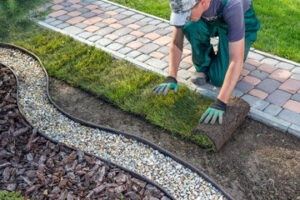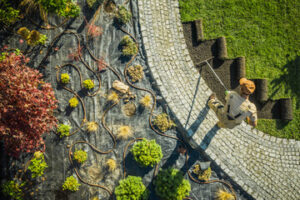Landscaping is the practice of adding plant material and altering terrain to create a harmonious relationship between dwelling and landscape. It includes garden design, lawn care, and water management.

Study the yards and landscapes that appeal to you. Pay attention to line, form, color, and texture. Also, consider the principles of composition-proportion, rhythm, dominance, and unity. Visit https://www.landscaping-greensboro.com/ to learn more.
Landscapers are trained professionals who know how to enhance the curb appeal of your property. They can use a variety of techniques and materials to create attractive outdoor spaces. They may also include hardscape features such as walkways and patios that will draw attention to certain areas of the yard. Landscapers can also help you make the most of your landscape with the use of plants that thrive in your climate and soil type. A well-designed landscape can increase the value of your home and improve the quality of your life.
Aesthetics is often used as a synonym for beauty, but it has a broader meaning. Aesthetics is the study of pleasure and is a component of philosophy, art, music, literature, and even economics. It is a way to understand the world around us and can be used to describe things such as the beauty of a tree or the pleasing arrangement of objects in a room. Aesthetics is also the reason why we enjoy some things more than others.
Traditionally, philosophical aesthetics focused on the concept of beauty. However, since the eighteenth century, philosophers have shifted their focus to other concepts as well. These concepts include elegance, the sublime, and other qualities related to the enjoyment of a work of art. The full field of what could be considered “aesthetics” is so broad that there are now four-volume encyclopedias dedicated to it.
Aestic is also a style that is popular in gardening and architecture. People who describe a garden or an architectural design as having an aesthetic often mean that it is pleasant to the eye and reflects a particular style, such as classical/neoclassical. This is similar to the way that people use “style” to refer to a person’s clothing, furniture, or house decor.
While many people associate landscaping with aesthetics, not all landscaping professionals are concerned with the appearance of a property. Landscapers who are not interested in maximizing the beauty of their designs may choose to use less plant material and instead place more emphasis on hardscapes. This can save on the cost of a landscape project while still increasing the curb appeal of a home. Landscapers who are focused on aesthetics may choose to install more sculptural elements such as water features and rock gardens.
Function
It’s not just about how a landscape looks; it also serves a functional purpose. Whether it’s providing shade, creating privacy, or controlling erosion, landscaping provides an array of practical benefits for homeowners.
Plants: The selection and placement of plants in the yard is crucial to a healthy and beautiful landscape. Proper plant selection helps reduce the need for pesticides and other chemicals, while ensuring that the proper amount of sunlight, water, and nutrients are received by the plants.
Soil: In addition to ensuring that the plants are growing in the best possible conditions, soil health is a vital aspect of landscaping. Landscaping techniques like mulching, adding organic compost, and amending the soil help provide the right balance of nutrients and moisture for the plants to thrive.
Hardscapes: In addition to plants, a well-designed landscape includes nonliving elements like walkways, patios, and retaining walls. Landscapers ensure that these elements are designed and constructed in a way that adds to the overall aesthetic of the property while serving a practical purpose.
Water Features: Ponds, waterfalls, and fountains can not only be aesthetically pleasing, but they can also serve as a focal point in the landscape, increase property value, and even attract wildlife.
Environmental Benefits: It’s no secret that our environment is being negatively impacted by the loss of green space and overuse of land. Landscaping can help improve the environment by reducing soil erosion, improving air quality, and creating habitat for local wildlife.
It’s also important to note that spending time in nature is beneficial for your mental and physical health. Research has shown that being surrounded by trees, flowers, and other plants can lower stress levels and promote feelings of happiness and contentment. With all of the benefits that landscaping can offer, it’s no wonder why so many people choose to take advantage of this beautiful and functional outdoor art form.
Maintenance
A well-maintained landscape enhances the beauty and value of a home or commercial property. It also provides an inviting space for people to relax and enjoy the outdoors. Landscaping includes the placement of flowers, trees, shrubs, and lawns as well as water features, rocks, mulch, outdoor furniture, and other decorative elements. Many different landscaping styles exist, from formal to informal, and can be tailored to suit individual tastes.
The primary objectives of gardening typically revolve around personal satisfaction, growing food, and enhancing beauty. Landscaping, on the other hand, is more broad in scope and combines both natural elements like plants and trees with constructed features such as walkways, patios, and retaining walls. It also includes regular maintenance activities like mowing, trimming, and edging.
Landscapers consider maintenance when creating a design plan. They may group plants with similar care requirements together to reduce the amount of time needed for weeding and mowing. They might also incorporate hardscapes into the design to help with drainage, increase privacy, and block noise from nearby streets or buildings.
Keeping up with monthly landscape maintenance is vital to a healthy and attractive yard. It helps prevent the onset of disease and insect infestations, keeps weeds in check, and ensures that plantings get adequate sunlight and nutrients. When neglected, however, a landscape can quickly become overgrown and unsightly, requiring more frequent and intensive maintenance.
When it comes to landscape design, the most important factor is to make sure that your outdoor spaces are functional and aesthetically pleasing. Some people choose to relegate most of their yard to natural areas and only maintain a small area for entertaining and relaxing, but this approach often requires more work than a landscape designed with function in mind.
A professional landscaper can create a garden that meets your needs while elevating your property’s curb appeal and increasing its overall value. They can also take the guesswork out of ongoing maintenance by offering services like pruning, fertilizing, pest control, and seasonal adjustments. This will give you peace of mind knowing that your yard is in the hands of experts.
Health
Despite the fact that landscaping is all about enhancing aesthetics, there are also many health benefits to having well-designed and properly maintained landscapes. Some of these benefits include:
Improved Air Quality: Plants can help to filter the air by absorbing carbon dioxide and releasing oxygen during photosynthesis. This is especially important in areas with high traffic or industrial zones. They can also provide shade, which can reduce the air temperature around homes and buildings, lowering cooling costs in the St. Louis summers. Plants can also help to lower noise pollution by acting as a buffer between homes and noisy businesses or roads.
Stress Reduction: Studies have shown that spending time in nature can help to reduce stress, anxiety and depression. Even simply looking at a beautiful flower or tree can make people feel relaxed and happy. Landscapes can offer a quiet retreat for people to relax in, enjoy the company of family and friends or simply get some sun and exercise.
Landscapes and trees can also provide a habitat for wildlife. Birds, bees and other insects are a vital part of the natural ecosystem and can help pollinate plants and keep pest populations under control. Landscapes that contain native and sustainable plantings can provide a natural habitat for these creatures to thrive.
Well-Littered Property: Well-lit pathways and well-kept landscapes can increase safety by deterring criminal activity and making it difficult for intruders to hide. In addition, a well-kept yard can create a safe space for children and pets to play outside without fear of being run over by cars or other hazards.
A Career in Landscaping: Working outdoors is good for your mental and physical health. It can help to relieve stress, lower blood pressure and strengthen the immune system. It can also increase job satisfaction, boost creativity and morale, and lead to a healthier lifestyle.
A career in the landscaping industry can be a rewarding and exciting experience. If you are interested in learning more about becoming a professional landscaper, send us an application today! We are always looking for hardworking individuals with a passion for the outdoors and a desire to grow and learn.
